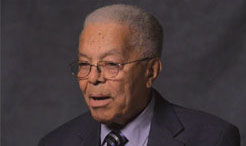 “I’m not a politician,” says the 92-year-old bespectacled man seated in his son’s pastoral study, followed by what appears to be an aesthetic pause and then a subtle grin. “I don’t look for what’s politically correct. I was there in public life to get advantages for my people.”
“I’m not a politician,” says the 92-year-old bespectacled man seated in his son’s pastoral study, followed by what appears to be an aesthetic pause and then a subtle grin. “I don’t look for what’s politically correct. I was there in public life to get advantages for my people.”
This is how the Rev. Nicholas Hood Sr. sums up his historic campaign for Detroit City Council fifty years ago, and it equally represents his 28-year tenure on the nine-person legislative body. On council, as the only black local government elected official, Hood helped to calm the city during civil unrest in 1967. He later led the way in advocating for ethnic diversity within the city Fire Department. Hood retired as church pastor in 1985 and from City Council in 1993 where he served as second in command for several years. In both instances his son, Nicholas III, carried on the mantle.
DETROIT BOUND
In 1958, Hood was summoned to the Motor City from Central Congregational Church in New Orleans to serve as pastor of Plymouth Congregational Church after the Rev. Horace White, his predecessor, died. White was a revered civil rights leader, first black to serve on the city’s Housing Commission, and a one-term state house member. Hood, a Purdue and Yale-educated man, hit the ground running. After Bill Patrick, Detroit’s first black council member since the late 1800s, resigned in 1963 to take a job with Michigan Bell Telephone Company, a special election was held in 1964 to replace him. Vying for the seat were Hood, Jackie Vaughn, an African American, and Thomas Poindexter, a white demagogue who led a raging crusade to protect neighborhoods from black residents. Hood and Vaughn garnered significant support from different factions. Hood earned the nod from the Michigan Chronicle, the state’s leading black newspaper; Vaughn solidified a portion of big labor support. Vaughn and Poindexter made the runoff in September. Poindexter was elected in November.
Undeterred, Hood again ran for a seat on council the following year. With a coalition of supporters that included blacks and whites as well as Mayor Jerry Cavanagh, the relatively new city resident was elected. It was a different approach from previous black council hopefuls who had anchored their campaigns on the lower east side sections of Black Bottom and Paradise Valley. In fact, Hood held his own against Poindexter in powerful, lily-white wards on the northwest and northeast sides. He scored a 2-1 margin over Poindexter in upscale Palmer Woods less than one mile from Poindexter’s home in the University District section of town.
“Nicholas Hood, a Negro minister elected by white churches and a biracial vote, will go to Common Council in January as the candidate of a city’s conscience,” a Detroit Free Press analysis of the campaign stated at the time.
“It’s a tremendous victory for the city in that I, as a candidate seeking unity for our city, have been able to replace one who openly sought to divide our city,” Hood said in 1965 about Poindexter.
URBAN RENEWAL OR NEGRO REMOVAL
During the early 1960s, Plymouth Congregational was one of the city’s most socially active and politically progressive homes of worship. The city government announced that 450 acres of land, including the land where the church stood, would be cleared for the expansion of the Detroit Medical Center footprint. Hundreds of black residents were destined to be displaced.
In response, Hood organized the Fellowship of Urban Renewal Churches and demanded that churches be allowed to either remain or relocate in the area. The Rev. Albert B. Cleage, Jr. who had trained under Horace White at Plymouth Congregational and ultimately founded the Black Nationalist-oriented Shrine of the Black Madonna in 1967, declared that medical center expansion and the construction of the Chrysler Freeway was systemic Negro removal.
Hood agreed. He lobbied federal and local officials and made sweet lemonade out of lemons:
“Yes, urban renewal is Negro removal. But we’re going make it work for us.”
His church’s nonprofit, armed with federal funds, built affordable housing and a facility to assist developmentally disabled adults called Cyprian Center in honor of his deceased daughter, Sarah.
“I was trying to save a part of the city for black folk,” said Hood. “That’s what these 50 acres represent.”